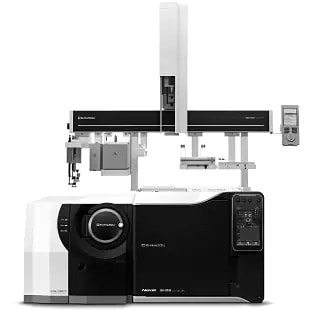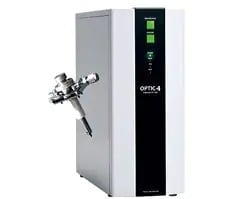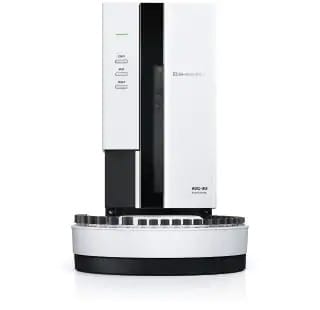Samples are pipetted directly into the GC injection port using a needle. Analytes are usually derivatized to lower their boiling point, allowing the sample to be injected at a lower temperature.
GCMS Sample Introduction Systems Selection Guide
Choosing a Sample Introduction Technique for GC/MS Analysis
This page provides a quick overview of sample introduction methods for analysis with gas chromatography-mass spectroscopy. It also indicates the Shimadzu GC/MS autosamplers compatible with each method. For a more detailed explanation, download our pdf guide.
Contents
1. What sample introduction techniques are available for GC/MS analysis?
Here we briefly describe the eight main techniques for GC/MS sample pretreatment and introduction.
-
-
Samples are pre-heated within the autosampler. More volatile components converge in the gas headspace, which is then sampled and injected into the GC.
-
Also known as “purge and trap”. Inert gas is introduced into the liquid sample to “purge” it. The volatile analytes are swept into an absorbent trap connected to the sample vial. The trap is then heated, releasing the analytes into the GC-MS system.
-
A portable sampling pump is used to collect field samples of gas in thermal desorption (TD) tubes filled with trap sorbents. Heating the tubes releases volatile analytes into the GC-MS using an adsorbent trap system.
-
Unlike the TD method above, the TD tubes are filled directly with solid samples. Heating the tubes releases volatile analytes, which may be introduced directly into the GC or pass through a trap sorbent.
-
A specialized SPME needle is injected directly into liquid samples or into a sample headspace for adsorption of analytes. The needle is then inserted into the pre-heated injection port and releases the analytes through heat desorption.
-
Small solid or liquid samples are placed in a small cup, which is attached to a heating probe and inserted directly into the ionization chamber without passing through a GC column. The sample is ionized through heating.
-
Used for less volatile or non-volatile compounds in liquid or solid samples. The sample is rapidly heated to 600-1000℃, releasing smaller, more volatile decomposition products that can then be separated and analysed by GC-MS.
Summary table
| Technique | Matrix | Target analytes | Shimadzu's GC/MS accessories | |
|---|---|---|---|---|
| Liquid injection (Liq) | Liquid (no sample prep) | Volatile or semi-volatile | AOC-30 series | AOC-6000 Plus series |
| Static headspace (SHS) | Liquid, (semi-)solid | Volatile | HS-20 NX series | |
| Dynamic headspace (DHS) | Liquid, (semi-)solid | Volatile | HS-20 NX Trap model | |
| Solid phase microextraction (SPME) | Gas, liquid, (semi-)solid | Volatile or semi-volatile | ||
| Thermal desorption (TD) | Gas, liquid, (semi-)solid | Volatile or semi-volatile | TD-30 series | OPTIC-4 |
| Direct thermal desorption(D-TD) | Liquid, (semi-)solid | Volatile or semi-volatile | EGA/PY-3030D | TD-30 series |
| Pyrolysis (Py) | Liquid, (semi-)solid | Less volatile, non-volatile | OPTIC-4 | |
| Direct sample injection (DI) | Liquid, (semi-)solid | Less volatile, non-volatile | DI-2010 | |
2. How does sample volatility affect the choice of technique?
Sample volatility is a key factor in selecting a sample introduction technique.
This chart shows the boiling points of various compound groups and the most suitable introduction methods over different volatility ranges.
3. How do sample matrices affect the choice of technique?
The figure below shows the most appropriate technique taking into account both sample volatility and the matrix interference. Analysis is difficult when the sample and its matrix have similar volatility.
4. What is the sensitivity range for each technique?
Below is the general sensitivity range for each technique. All of these techniques can be used for trace-level analysis when paired with a high-sensitivity MS detector.
| Technique | Sensitivity | Shimadzu's GC/MS accessories | |
|---|---|---|---|
| ppb~ppm level | |||
| ppt~ppb level | |||
| ppt~ppb level | |||
| ppt~ppb level | | ||
| ppt~ppm level | |||
| ppb level | |||
| μg level | | ||
| ng level | |||
News / Events
-
Latest issue of Shimadzu Journal, featuring Environmental Analysis, has come out.
This issue showcases advanced technologies and research tackling the global challenges posed by PFAS. As part of Shimadzu’s ongoing commitment to sustainability and problem solving, we strive to reduce environmental impacts and build a better future.
-
Automatic Derivatization System for Phenethylamine Drugs
This system allows the on-column derivatization using auto-injector AOC-30i and a LabSolutions GCMS system that is now equipped with 2-step injection. On-column derivatization allows for the direct analysis of extracted urine samples without additional sample pretreatment, which can significantly shorten the time required for derivatization.
-
AOAC INTERNATIONAL Posters are now available.
-
Shimadzu has released the GCMS-QP2050
The next-generation GCMS-QP2050 gas chromatograph mass spectrometer, with its accumulation of impressive Shimadzu technology, will lead the way forward. New value is provided by hardware boasting astounding reliability and stability, and easy-to-operate software equipped with superior automated technology.
-
Solutions for Analysis of Ethylene Oxide and 2-Chloroethanol in Food
Even though Ethylene oxide (EtO / EO) is well-known to be a toxic compound with carcinogenic and mutagenic concerns, it has been widely used for fumigation in the food industry because it effectively reduces or eliminates microbiological contamination with bacteria/fungi. The recent recall of food products exported to the EU due to non-compliance with EU regulations has highlighted the importance of quantitation of EtO and 2-CE residues in food.
-
Latest issue of Shimadzu Journal, featuring Forensics / Toxicology, has come out.
This issue focuses on "Forensics / Toxicology", an area where science and technology are particularly important and needed. It starts with two customer interviews.



.jpg)

.jpg)




